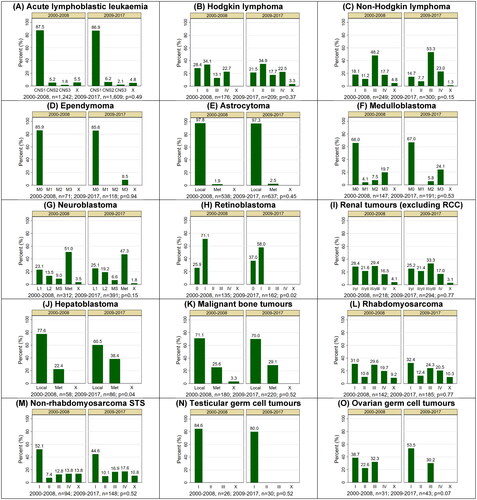Figures & data
Table 2. Study cohort by selected characteristics and period of diagnosis, Australia, 2000–2017.
Figure 1. Incident distribution of stage at diagnosis by type of childhood cancer and period of diagnosis, Australia, 2000–2017a,b,c,d. CNS: central nervous system; Local: localised; Met: metastatic; RCC: renal cell carcinoma; STS: soft tissue sarcoma. Staging categories: Ependymoma and medulloblastoma (M0 - no visible metastases on imaging and no tumour cells in the CSF; M1 - tumour cells in the cerebrospinal fluid; M2 - visible metastases in brain; M3 - visible metastases in spine; M4 - metastasis outside of CNS); Neuroblastoma (L1 - localised; L2 - locoregional; MS - metastases confined to skin, liver, and/or bone marrow for children younger than 18 months old at diagnosis); Renal tumours (y – denotes patients treated on the SIOP protocol); X – stage not assigned. (a). Type of cancer classified according to the International Classification of Childhood Cancers, version 3 (ICCC-3). (b). Cases were staged using the Toronto Paediatric Cancer Stage Guidelines. (c). P-values are for comparison of the stage distribution between the two diagnosis periods and were calculated after excluding cases with unknown stages at diagnosis. (d). Bars relating to cell counts of 5 or fewer patients are shown as missing to protect confidentiality.

Figure 2. Differences in adjusted survival curves from 2000–2008 to 2009–2017 for selected combinations of childhood cancer type and stage at diagnosis, Australia.a,b,c ALL: acute lymphoblastic leukaemia; CNS: central nervous system. Staging categories: Acute lymphoblastic leukaemia (CNS1 - No clinical signs of central nervous system involvement and no blasts in the cerebrospinal fluid); Medulloblastoma (M3 - visible metastases in spine); Neuroblastoma (excludes stage MS - metastases confined to skin, liver, and/or bone marrow for children younger than 18 months old at diagnosis); Renal tumours (y – denotes patients treated on the SIOP protocol). (a) Survival was followed to 31 December 2020. Shaded areas denote the 95% confidence interval for the difference in survival. Positive values indicate survival has improved between the two diagnostic time periods. (b) Type of cancer classified according to the International Classification of Childhood Cancers, version 3 (ICCC-3). (c). The stage was defined by the Toronto Paediatric Cancer Stage Guidelines. d. Excludes renal cell carcinomas.

Table 3. Five-year observed survival by stage at diagnosis, type of childhood cancer and period of diagnosis, Australia, 2000-2017a.
Supplemental Material
Download MS Word (19.6 KB)Supplemental Material
Download MS Word (19.3 KB)Data availability statement
Unit record data that support the findings of this study are not publicly available through the Australian Childhood Cancer Registry due to privacy and ethical restrictions but may be requested directly from the data custodians at the state and territory cancer registries and treating hospitals (subject to all necessary ethics approvals). Please contact [email protected] for further details.
